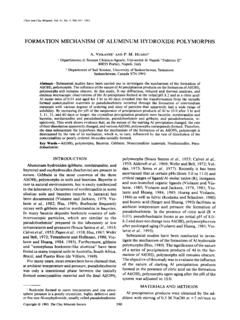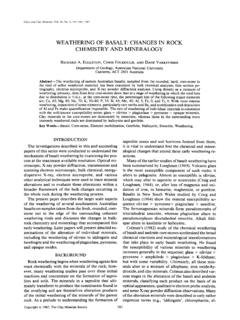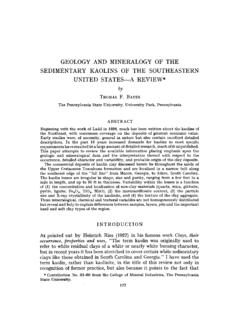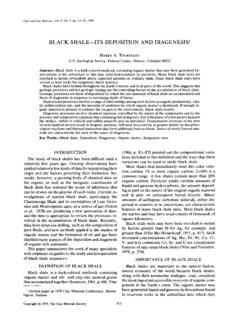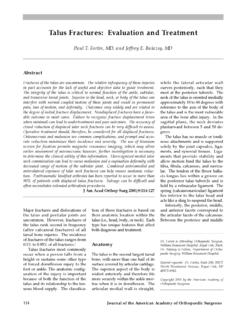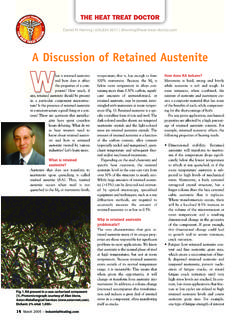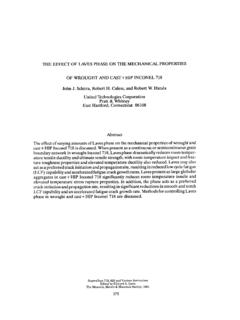Transcription of USE OF CLAYS AS PETROLEUM CRACKING CATALYSTS
1 USE OF CLAYS AS PETROLEUM CRACKING CATALYSTS Bi- T. H. MiLLIKEN,* A. G. OBLAD,** AND G. A. MILLS** Introduction. The use of CATALYSTS in the PETROLEUM industry in recent years has undergone a remarkable expansion. The most important of these CATALYSTS are employed in cracliing processes, first introduced in 1936 (Houdry et al., 1938). As a consequence of the growth of catalytic CRACKING , the manufacture of CRACKING cata-lysts has in itself become a major industry with an esti-mated sales value of $61,000,000 in 1952.
2 Principal em-phasis has been placed on two tj^pes of CATALYSTS both essentially composed of silica and alumina, one derived from clay and the other synthesized from aluminum and silicate solutions. A total of approximately 470 tons per day of CRACKING CATALYSTS are manufactured and used to process about 2,000,000 barrels of crude daily. Clay cata-lysts account for about 40 percent of the total manufac-ture. Such a special use of CLAYS has placed requirements on these materials significantly different than those met in other uses of CLAYS .
3 Moreover, the very particular physical and chemical properties required for good com-mercial hydrocarbon- CRACKING CATALYSTS limit the eco-nomic use of CLAYS to specific types. Until recently, only a few deposits of subbentonites were of commercial inter-est for catalyst manufacture. As in certain other uses of the surface properties of CLAYS , it is the peculiar structural features of CLAYS which enables them to play a special role for catalyst manu-facture. At present only two CLAYS are used for the preparation of commercial CRACKING catalyst: montmorillonite and halloysite.
4 The patent literature cites many other nat-urally occurring materials as sources of such CATALYSTS ; kaolinite, vermiculite, and bauxite, for example. In this paper, only montmorillonite, halloysite, and kaolinite will be discussed. The general properties of CRACKING cata-* Assistant Director of Researcli, Houdry Process Corp., Researcli and Development Laboratories, Marcus Hook. Penn. ** Associate Manager of Researcli and Development, Houdry Proc-ess Corp., Research and Development Laboratories, Marcus Hook, Penn.
5 * * Director of Research, Houdry Process Corp., Research and De-velopment Laboratories, Marcus Hook, Penn. lysts and raw CLAYS from which they are manufactured are shown in table 1, which presents comparative data for chemical, physical, and catalytic properties. The catalyst is employed in the CRACKING of heavy PETROLEUM fractions. In such a process, oil, more or less in the vapor state, is passed over the catalyst at 425-500""C, atmospheric pressure, and contact times of 6-20 seconds. Under the directive influence of the catalyst, a series of complicated reactions (Greensfelder, 1951) takes place with the consequent products much different from those obtained in thermal CRACKING .
6 Catalytic CRACKING is employed in the PETROLEUM industry because of the high quality of gasoline produced and because of the desirable distribution of products. Typically, some 6 percent of a methane to propane fraction, 10 percent butanes, 45 percent gasoline, and 40 percent recycle oil are pro-duced. At the same time 1 to 3 percent of the charge stock is deposited on the catalyst as a nonvolatile hydro-carbonaceous residue commonly called "coke." After a 10 to 20 minute CRACKING period the coke is removed from the catalyst by controlled combustion.
7 In this burning process, the temperature is limited to perhaps 600 C, although a higher local surface temperature may prevail. After such a regeneration the catalyst is ready for reuse. During use at elevated temperatures, the cata-lyst is exposed to various organic compounds including those containing oxygen, sulfur, nitrogen, as well as heavy metals contained in the charge stock. In addition, the catalyst must withstand water over a wide range of vapor pressures. Whereas early commercial catalytic CRACKING apparatuses utilized a fixed bed, present day units utilize moving beds with transfer of the catalyst from a CRACKING zone to a regeneration zone.
8 (Ardern et al., 1951; Murphree, 1951). A typical process is illus-trated by the flow sheet shown in figure 1. In order to maintain a "heat balance" between the endothermic vaporization and CRACKING of the hydrocarbons and the exothermic regeneration, a large quantity of catalyst must be circulated continuously. Depending upon re-Chemical \l2O3 - --MgO --- -- .--Fe203 - -----CaO --- ->fa20 Physical Catalytic Table 1.
9 Properties of (new) CRACKING CATALYSTS after calcination at 55V C. Synthetic SiOj-AljOj 0 300-600 45-50 Si02-MgO 650 45-50 Clay Montmorillonite Raw 5 Activated 300 40 Houdry type 1 230 40 Raw 12-20 Halloysite Activated 160 35-40 Physical and catalytic properties on fresh CATALYSTS after calcination at about 550* C. ( 314 ) Part VII] CLAY TECHNOLOGY IN THE PETROLEUM INDUSTRY 315 HOUDRIFLOW FEED HEATER EXCESS FLUE GAS FIGURE 1 finery requirements, to tons of catal3'st are cir-culated per barrel of crude charged.
10 This tremendous circulation requires a high degree of physical stability. In short, the catalyst must maintain CRACKING activity when svibjected to high temperatures, chemical attack from steam and contaminants in the charge, and have good resistance to abrasion. CRACKING CATALYSTS From Montmorillonite. There is no known chemical or physical test which will enable one to predict whether or not a particular montmorillonite clay will respond to acid treatment and produce a cata-lyst of high activity.


